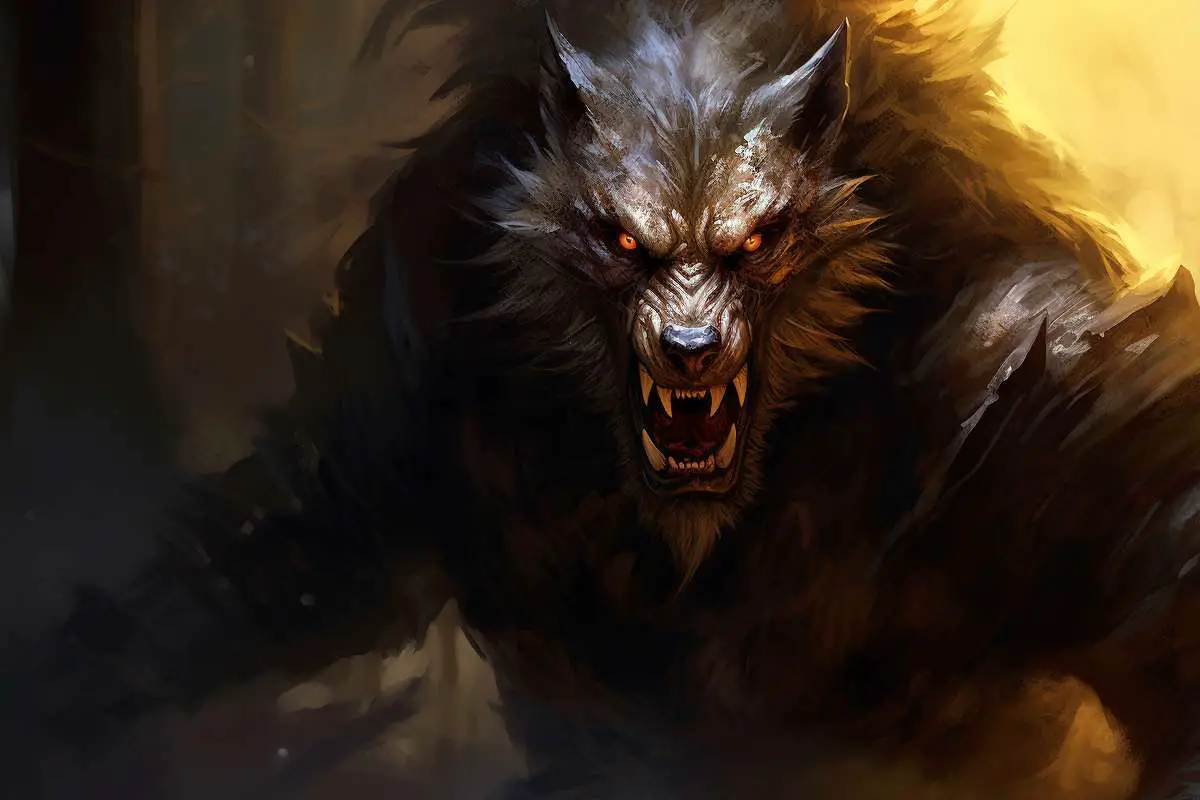
Since ancient times, the wolf has stirred both awe and fear in the human heart. Its primal ferocity, savage powers and mystical connection to the moon evoke a sense of the untamed wilds within us all. In Dungeons & Dragons, the legend of the werewolf encapsulates these primal contradictions. Cursed beings trapped between animal and human, both Dr. Jekyll and Mr. Hyde in one body, they exemplify the struggle between civilization and raw bestial instincts that form the heart of so many great stories.
Today we will explore many facets of werewolves in D&D’s 5th edition – their bizarre transformations, savage tactics, rich lore and presence across many official adventures. Whether you seek to unleash the beast within your players, challenge heroes with these lupine foes or weave an epic tale of lycanthropy’s curse, the articles ahead provide insights to incorporate the terror and grandeur of werewolves into your own D&D games. Let us delve into the mysteries of the wolf…
How does lycanthropy work in D&D 5e?
Lycanthropy in D&D 5e functions as a curse that causes a humanoid creature to transform into a dangerous hybrid form or animal against their will. There are several types of lycanthropy corresponding to different animal forms, the most common being werewolves.
A humanoid creature can contract lycanthropy in several ways – if they are bitten by a creature already afflicted with the curse, if they consume werewolf blood, flesh or other body parts, or through a curse invoked with magic. Once contracted, lycanthropy manifests in three stages:
- Dormant Stage: The lycanthrope has no signs or symptoms of the curse. They do not involuntarily change form.
- Lycanthropy Stage: Each full moon, the lycanthrope transforms into a bloodthirsty, uncontrolled hybrid form – a werewolf, werebear, etc. They revert back after the moon sets. In wolf form, they cannot communicate and have the drive to kill.
- Controlled Stage: After passing three successful DC15 Wisdom saving throws over the course of three months, the lycanthrope gains control over their transformations and keeps their personality while transformed. They can change at will.
A lycanthrope stays stuck in the lycanthropy stage until they gain control. Common ways to become cured are through the remove curse spell or drinking a potion of restorative. Once cured, the creature is immune to contracting that form of lycanthropy again. Lycanthropy is often used in D&D as a narrative device and to create challenging creature encounters.
What are the stats for a werewolf in D&D 5e?
In the Monster Manual for D&D 5e, a werewolf is listed as a medium humanoid (human, shapechanger) with the following key stats:
- Armor Class: 11 in humanoid form, 12 (natural armor) in wolf and hybrid forms
- Hit Points: 58 (9d8 + 18)
- Speed: 30 ft. (40 ft. in wolf form)
- Abilities: +2 Strength, +1 Dexterity, +1 Constitution
- Skills: Perception +3, Stealth +2
- Damage Immunities: Bludgeoning, Piercing, and Slashing damage from nonmagical attacks not made with silvered weapons
- Senses: Passive Perception 13
- Languages: Common (can’t speak in wolf form)
- Challenge Rating: 3
In hybrid and wolf form, the werewolf has a multiattack option to make two attacks – one with its bite (2d4 + 2 piercing damage) and one with its claws (2d4 slashing damage). It also has the option to make just one bite attack.
The lycanthropic curse grants it shapechanger abilities, allowing it to polymorph into a wolf-humanoid hybrid or wolf on its turn. It gains advantage on hearing and smelling checks and has keen senses. The werewolf’s howl in wolf form is considered a supernatural effect that forces a DC12 Wisdom saving throw or become frightened. Overall, a dangerous foe combining agility, sharp senses, and savage attacks.
How does a character become a werewolf in D&D 5e?
There are a few common ways a player character could become afflicted with lycanthropy and turn into a werewolf in a D&D 5e campaign:
- Werewolf Attack: The most straightforward way is being bitten by another werewolf while it is in wolf or hybrid form. The werewolf must break the skin and draw blood for the curse to afflict the victim. The victim must make a DC 15 Constitution saving throw or become cursed.
- Consuming Werewolf Flesh/Blood: Eating the flesh or drinking the blood of a werewolf (most often done unwittingly) forces the consumer to make a DC 15 Constitution saving throw or become cursed with lycanthropy.
- Curse: Certain magic curses could inflict lycanthropy without needing physical transmission. A curse spell or interaction with a cursed magic item could lead to contracting the disease. No save is allowed.
- Reincarnation: If a character dies while afflicted with lycanthropy and is later resurrected or reincarnated, they revive still cursed by the lycanthropy.
Once cursed, the signs of lycanthropy manifest at the next full moon when they first involuntarily shapeshift. To control it, they need to pass three DC 15 Wisdom saving throws over three months. Player lycanthropes need to be closely monitored by the DM to maintain control. It can serve as an interesting character arc to try to overcome the savage curse.
What abilities and traits do werewolves have in D&D 5e?
Werewolves in D&D 5e gain the following abilities and traits related to their lycanthropic curse:
- Shapechanger: As an action, the werewolf can polymorph into a wolf-humanoid hybrid form or wolf form, or back into its true humanoid form.
- Keen Hearing and Smell: The werewolf has advantage on Wisdom (Perception) checks that rely on hearing or smell.
- Predatory Instincts: In wolf or hybrid form, the werewolf’s attacks require the target to make a DC 12 Wisdom saving throw or become frightened until the end of the werewolf’s next turn.
- Rampage: When the werewolf drops to 0 hit points but isn’t killed outright, it must make a DC 15 Wisdom saving throw or go on a rampage and attack the nearest creature for 1 round before dying.
- Natural Weapons: The werewolf’s fanged bite and razor-sharp claws are natural melee weapons that deal piercing and slashing damage.
- Regeneration: The werewolf regains 10 hit points at the start of its turn if it has at least 1 hit point and it’s not in sunlight or silvered weapons have not damaged it since its last turn.
- Immunity to Bludgeoning, Piercing, and Slashing: From nonmagical attacks not made with silvered weapons
- Curse of Lycanthropy: Humanoids hit by a werewolf’s bite attack in wolf or hybrid form must make a DC 15 Constitution saving throw or become afflicted with the curse of lycanthropy.
A werewolf is a terror in combat, combining animalistic savagery with a cunning human intellect. With their shapechanging ability, overwhelming attacks, and frightening presence, they can quickly overwhelm unprepared adventurers.
How can a werewolf be cured in D&D 5e?
There are a few methods in D&D 5e that can be used to rid a character of the curse of lycanthropy that transforms them into a werewolf:
- Remove Curse Spell (5th Level): A 5th level cleric or paladin can cast the remove curse spell on the afflicted lycanthrope. This removes the curse if cast during the dormant stage or while the target is in humanoid form.
- Potion of Restorative: Drinking this magic potion cures a character of all curses afflicting them, including lycanthropy. The potion is very rare and difficult to obtain in most campaigns.
- Controlled Transformation: If the lycanthrope can maintain control during their transformations and resist attacking humans for 1 year, the DM can rule the curse has been lifted. This requires passing 3 DC 15 Wisdom saves first.
- Wish Spell: The mighty wish spell can directly undo the curse of lycanthropy or even rewrite reality so the character was never afflicted at all. At the DM’s discretion, the curse could be beyond even wish.
- Divine Intervention: If the infected creature is of the same religious faith as a high-level priest, cleric or paladin, that holy champion can plead to their god to cure the lycanthropy. Success is based on a percentage roll.
- Alchemy: In some realms, alchemists have concocted potions to cure lycanthropy using the blood of the inflicted, wolfsbane and rare ingredients. The DM can introduce such a cure as a quest object.
While not easy to break, lifting the werewolf curse brings great relief as the former lycanthrope no longer fears what they may do under the moon’s light. Of course, immunity to further infection is a nice bonus too.
Can a player character be a werewolf in D&D 5e?
Yes, it is possible for a player character to become a werewolf in D&D 5e, though it requires working closely with the Dungeon Master:
- The PC must first contract lycanthropy through being bitten by a werewolf or other means. There is then a period where they struggle to control the transformations and animalistic urges.
- With effort and successful Wisdom saving throws, the PC can gain control while in werewolf form, no longer attacking friends and allies or losing their personality.
- In wolf or hybrid werewolf form, the character gains immunity to non-magical attacks not made with silver, advantage on hearing and smell checks, and natural melee weapons like claws and bite attacks.
- In humanoid form, they may still feel urges and behavior changes influenced by the wolf within them, based on the DM’s discretion.
- While transforming, the player loses control of their character until they return to humanoid form or regain control while transformed. The DM plays the werewolf during this time.
- If the player wants to be cured later, they must seek out powerful magic like the remove curse spell or potion of restorative from a high-level cleric or archmage.
- Special feats like Wolfkin further integrate the lycanthropy into the PC’s abilities and give them more control over it.
Overall, intelligent player werewolves present special challenges but can make for interesting roleplaying opportunities and storylines as they try to overcome and control their lupine curse. Close cooperation with the DM is needed to make sure the lycanthropy mechanics are handled fairly.
What is the lore and background of werewolves in D&D 5e?
Werewolves have a long history in D&D’s worlds, typically presented as savage creatures to be feared:
- Werewolves are humans cursed with lycanthropy – an affliction causing an involuntary transformation into a vicious wolf-like humanoid during the full moon.
- In D&D, lycanthropy can be spread through bites, flesh consumption or curses. Afflicted individuals turn feral and bloodthirsty during transformation.
- Different interpretations of werewolves exist across D&D’s campaign settings. In the Forgotten Realms, werewolves worship Malar the Beastlord. In Ravenloft, they are tragic gothic figures.
- Many werewolves organize themselves into packs with an alpha male or female leading them. They lurk in deep woods and prey upon humanoid settlements and travelers.
- Werewolves have a noted hatred of elves and will go out of their way to target them. Some legends say elves cursed humans with lycanthropy long ago, leading to an ancient feud between the races.
- Tales of werewolves being killed only by silvered weapons or wolfsbane plant are common in D&D lore. Clerics and paladins who can cure diseases are seen as a threat.
- Player characters afflicted with lycanthropy can attempt to control their bestial natures. But they are haunted by the fear they may one day lose control and turn upon their friends and allies.
- Notable D&D modules featuring werewolves include The Silver Key from the Forgotten Temple of Tharizdun, Howling Delve and Night of the Walking Dead among many others.
With their savage fury, physical power, and dark curse, werewolves make iconic supernatural threats in many D&D settings and stories. The lure of the wolf is strong for adventurers too cursed to control their bloodlust.
How does a werewolf’s shapechanging work in D&D 5e?
A werewolf’s ability to shapechange into different forms works as follows in D&D 5e:
- Actions: Shapechanging takes an action in combat. The werewolf can transform between its humanoid, wolf, and wolf-humanoid hybrid forms.
- Armor Class: The werewolf’s AC changes based on form – 11 in humanoid, 12 in wolf and hybrid.
- Hit Points: Hit points remain the same no matter what physical form the werewolf is in. Damage does not carry over between forms.
- Equipment: Any equipment worn or carried by the werewolf melds into their body while shapechanged. The equipment becomes non-functional but reappears when returning to humanoid form.
- Stats: Strength, dexterity, constitution and other stats modify in the new form based on the Monster Manual werewolf entry. The werewolf keeps its alignment and personality traits between forms.
- Involuntary Change: On the night of a full moon, the werewolf must succeed on a DC 15 Wisdom saving throw or involuntarily shift into their wolf or hybrid form. They revert back to humanoid form after the moon sets.
- Pack Tactics: In wolf form only, the werewolf has advantage on attack rolls against creatures if at least one ally is within 5 feet of that creature.
- Full Moon Rampage: On nights of the full moon, the DM takes control of the werewolf’s actions. They go on a rampage seeking humanoid blood and flesh. Player characters with lycanthropy lose control on full moon nights.
The waxing and waning of the moon brings both power and dread to the werewolf as its form shifts with the lunar phases. Mastering control over the changes can be a long struggle.
How do werewolves interact with silver weapons in D&D 5e?
- Werewolves have immunity to nonmagical damage not caused by silvered weapons. Attacks from normal weapons simply glance off their hide.
- Weapons made from silver or coated in alchemically-treated silver count as magical for purposes of overcoming this damage immunity.
- If a silver weapon strikes a werewolf, its damage is not reduced by the werewolf’s immunity. The silver prevents the supernatural toughness from protecting it.
- Silvered weapons are among the most reliable ways for monster hunters, slayers and heroes to fight back against werewolves and other lycanthropes.
- Some legends say silver’s purity disrupts evil energy and dark curses, which is why it is toxic to werewolves and other creatures of darkness.
- If a werewolf takes damage from a silvered weapon, it cannot use its regeneration trait on the next turn. The silver prevents the magical healing.
- Werewolves fear and hate silver weapons. Even in humanoid form, most will flee rather than face an opponent wielding silvered blades, arrows or bolts.
- Adventurers who know they will be facing werewolves should invest in silvering their existing weapons or buy silver weapons from town blacksmiths or temples.
- If caught without silver, heroes may need to get creative, using fire, magics like moonbeam or other environmental advantages to win the day.
With immunities that blunt normal weapons, only the shining radiance of silver provides the means to cut down these savage lycanthropic beasts. Werewolves rightfully fear the deadly kiss of silvered blades.
What adventure modules or campaigns feature werewolves in D&D 5e?
Werewolves make exciting adversaries in many D&D 5e adventure modules and campaigns:
- Curse of Strahd: Werewolves featured in several areas are loyal servants of the vampire lord Strahd von Zarovich. They may play a role in turning player characters.
- Storm King’s Thunder: Werewolves serving the villain Iymrith live among regular tribesman in the Reghed Glacier area and can pose a threat to PCs.
- Tales from the Yawning Portal: In The Forge of Fury, a werewolf pack lurks in the dungeons below the dwarf stronghold.
- Ghosts of Saltmarsh: The mystery adventure The Sinister Secret of Saltmarsh involves a haunted house occupied by wererats and a werewolf smuggler gang.
- Rime of the Frostmaiden: As endless winter grips Icewind Dale, desperate folk turn to warewolf rituals to survive the cold, creating packs of icy werewolves.
- Homebrew Content: DMs can easily insert werewolves into urban adventures, haunted forests, or old gothic castles. Danger lurks on the next full moon!
- Full Moon Saga: This classic adventure trilogy for levels 6-10 pits heroes against a werewolf lord seeking to dominate the land under the full.
Final thoughts
And so we have explored many aspects of the werewolf’s curse – from understanding their bizarre transformations, to tactics for battling against their savage fury with silver blades in hand. Through it all, we see how werewolves represent an alluring contradiction – man blended with beast, sanity with madness under the moon’s sway. They call to mind ancient legends, evoke gothic themes of hidden monsters and inspire us to control the wildness within.
For Dungeon Masters, the lycanthropes offer many story hooks – heroic quests to lift curses, mysteries of savage murders in the night and omens of the wolfsbane blooming once more. These savage shapechangers can lead players down paths of self-reflection, teach harsh lessons or push them to embrace their own inner beast. And the howls of werewolves shall forever stir the hearts of adventurers who know the moon-kissed monsters still lurk in the shadows of the world’s deepest forests.




